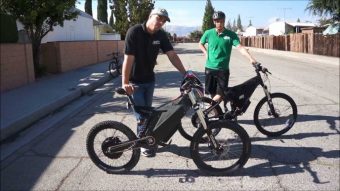Cars are not the only electric vehicles set to embrace connected and automated technology.
QUT researchers are looking at augmented reality for e-bikes to make them safer and provide a more enjoyable ride.
Augmented reality has the potential to provide real-time information that improves rider safety, such as projecting blind spot visualisations and navigating riders through the safest routes, Dr Ronald Schroeter from QUT’s Centre for Accident Research & Road Safety – Queensland (CARRS-Q) says.

Schroeter says cycling is one of the fastest growing modes of transport in Australia, yet Brisbane’s hilly terrain and humid climate meant it was not the best fit for bikes, at least not the push type.
“Not only are we seeing a greater uptake in the use of electric bikes, we are also seeing a change in the type of riders,” Schroeter says.
“Today the e-bike is not just for older cyclists who are looking for an easier ride – they are now common with commuters, university students and delivery drivers who see the benefits.”
Schroeter says this higher demand highlights the need to plan for both the increase in number of riders, as well as more inexperienced riders, on our roads.
“By designing innovative interactive devices it will be possible to improve safety and the enjoyment of riders.”
Dr Markus Rittenbruch from QUT’s Design Lab says developing display and interactive technology that directly integrates with bicycles offers huge potential.
He says technology could be used to connect bikes to other bikes and infrastructure, in the same way as connecting cars to other cars and infrastructure.
Rittenbruch says cyclists are vulnerable road users.
“Adverse road conditions such as potholes, gravel and slippery wet leaves can have an instant impact on a rider’s ability to control their bike with potentially severe consequences.
“As an example, we believe that it is possible to develop the technology and the interface to safely share this information cyclist-to-cyclist and other with authorities in charge of fixing the safety issue.
“There is also the untapped potential of cars talking to bikes and alerting the rider of heavy traffic ahead or if a vehicle is approaching at a risky speed.”
Brisbane e-bike distributer Nick Willis says: “What we have seen over the past five years at Electric Bikes Brisbane is that e-bikes have definitely encouraged more people to leave their car at home. Particularly since Queensland adopted the new European Standard allowing the more powerful 250 watt motors back in 2013.
“More and more two-car families are ditching one of their cars in favour of an e-bike, and we are also seeing school leavers opting to get an electric bike instead of a car, some determined never to buy a car.
“As a form of transport this generates significant financial savings (around $150 a week) but our e-bikers are also getting fitter and healthier because they are building light exercise into their daily routines. This has enormous additional benefits for our health and community welfare.”
As part of United Nations Global Road Safety Week and Australia’s Yellow Ribbon National Road Safety Week, CARRS-Q is launching a Queensland-wide initiative Watch your Pace when Sharing Space in Samford Village on May 12.
It’s a free community road safety event from 2pm-5pm at John Scott Park, Station Rd.







